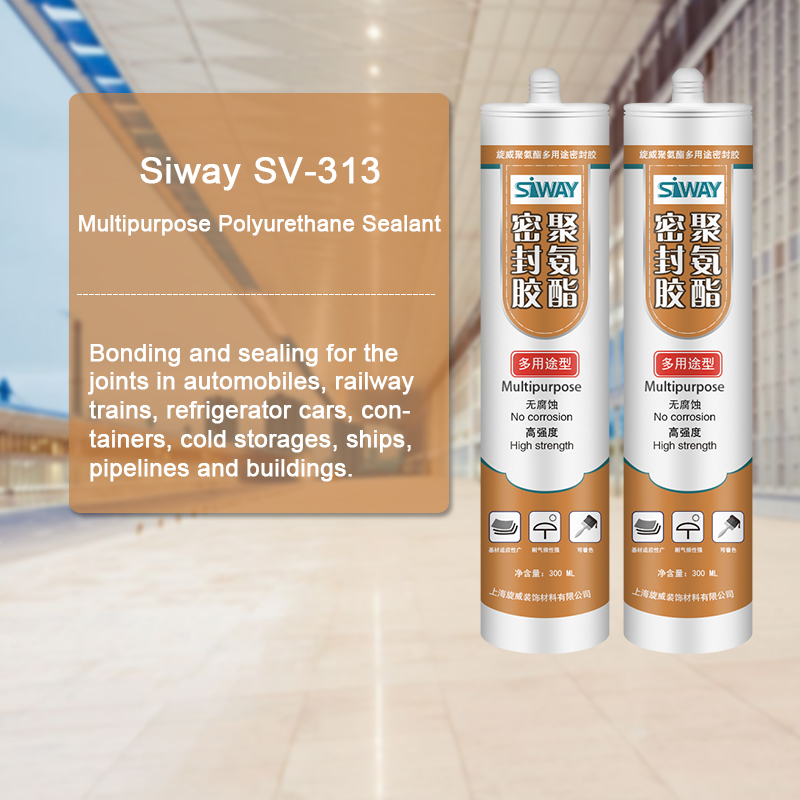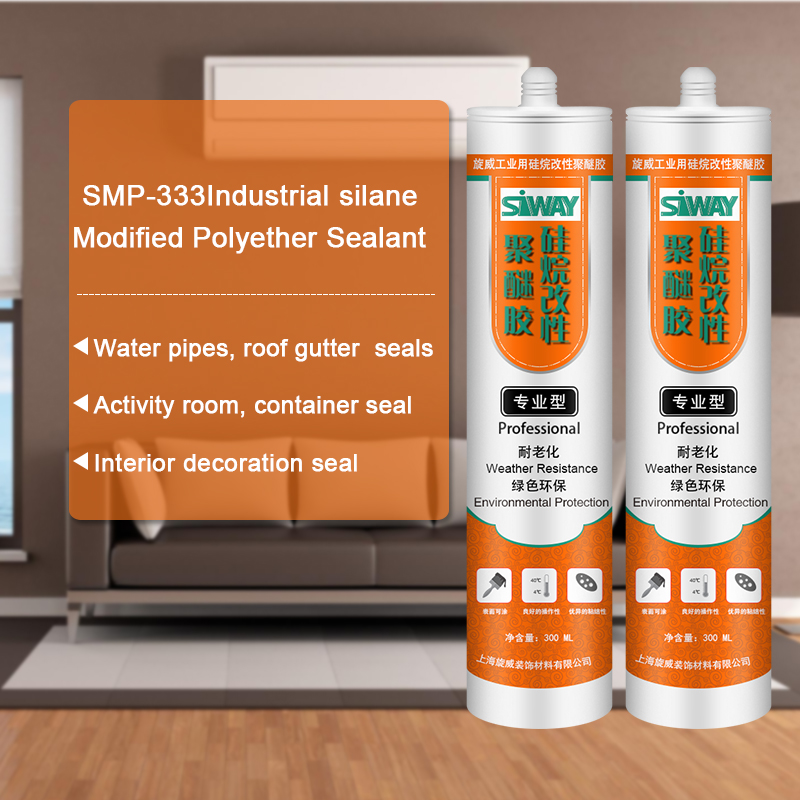13 Years Factory SV-999 Structural Glazing Silicone Sealant for Portland Factory
Short Description:
Description SV – 999 silicone structural sealant is a one-component, neutral curing, designed for glass curtain wall, aluminum curtain wall, glass daylighting roof and metal structural engineering structural assembly silicone sealant. Show the effective physical properties and bonding performance Key Features 1. 100% silicone 2. No sag 3. Strong bonding strength 4. Water & weatherproof 5. Primerless adhesion to most building materials 6. 25% movement capability Basic Application...
We always continually provide you with the most conscientious customer service, and the widest variety of designs and styles with finest materials. These efforts include the availability of customized designs with speed and dispatch for 13 Years Factory SV-999 Structural Glazing Silicone Sealant for Portland Factory, Please send us your specifications and requirements, or feel free to contact us with any questions or inquiries that you may have.
Description
SV – 999 silicone structural sealant is a one-component, neutral curing, designed for glass curtain wall, aluminum curtain wall, glass daylighting roof and metal structural engineering structural assembly silicone sealant. Show the effective physical properties and bonding performance
Key Features
1. 100% silicone
2. No sag
3. Strong bonding strength
4. Water & weatherproof
5. Primerless adhesion to most building materials
6. 25% movement capability
Basic Application
1.Glass curtain wall, aluminum curtain wall structure adhesive seal
2.Glass daylighting roof, metal structure engineering
3.Insulating glass bonding
Technical data sheet
| Test standard | Test project | Unit | value |
| Before curing——25℃,50%R.H. | |||
| specific gravity | g/ml | 1.40 | |
| GB13477 | Flow, sagging or vertical flow | mm | 0 |
| GB13477 | Operating time | min | 15 |
| GB13477 | surface drying time(25℃,50%R.H.) | min | 40-60 |
| Sealant curing speed and operating time will have different with different temperatures and temperature, high temperature and high humidity can make sealant curing speed faster, rather low temperature and low humidity are slower.21 days after curing——25℃,50%R.H. | |||
| GB13477 | Durometer Hardness | Shore A | 40 |
| The ultimate tensile strength | Mpa | 1.3 | |
| GB13477 | Tensile strength(23℃) | Mpa | 0.8 |
| GB13477 | Tensile strength(90℃) | Mpa | 0.5 |
| GB13477 | Tensile strength(-30℃) | Mpa | 0.9 |
| GB13477 | Tensile strength(flooding) | Mpa | 0.6 |
| GB13477 | Tensile strength(flooding – ultraviolet) | Mpa | 0.6 |
Certification
GB 16776;ASTM C1184
Color
Black
Package
300ml in cartridge * 24 per box, 500ml in sausage *20 per box
Shelf life
12 months
Note
If you want the TDS or MSDS or other details, please contact with our sales person.
Hey guys!! A lot of you asked me to make more color changing things, so today I bring you this super cool and really easy color changing phone case!
The first thing you will need is some sticker or adhesive paper. You can find this at any craft store. Take any phone case that fits your phone, it doesn’t have to be transparent or anything and trace the outline on the paper, don’t make it perfect, it’s just a guide.
I’m going to use some color changing paint mixed with some color changing pigment to make the effect stronger:
In ebay spain:
https://www.ebay.es/itm/151253215490?_…
In ebay.com (lots of options):
https://www.ebay.com/sch/i.html?_odkw=…
So I’m just mixing a little bit of both and painting on the sticker paper. Let it dry before adding a second layer, and you can also add a layer of mod podge or varnish to protect it and make it shiny.
After letting everything dry, trace the outline of your phone case again including the camera holes and stuff and cut it out!
Then just stick it to your phone case and that’s it! You can try and paint directly onto the phone case too, but I wanted something a little less permanent. Now let’s try it out!
As you see, it works fine and the finger prints left have a lot of detail! This is how it looks cold and hot. And it will also tell you if your phone is heating up too much from charging!
Music by: let’s go! by CMA
Overlays by Gabrielle Marie at: https://www.youtube.com/user/GlamSolu…
Now I have a P.O. box (don’t write DIYlover or anything just this):
APARTADO DE CORREOS 3017
20002 DONOSTIA (GIPUZKOA)
SPAIN
More DIYlover at:
Twitter: https://twitter.com/DIYlover89
Instagram: https://instagram.com/diylover89
Tumblr: https://diylover89.tumblr.com/
***VISIT OUR SPONSORS***
https://www.traderadiators.com | https://www.grahamplumbersmerchant.co.uk | https://www.buteline.com/uk | https://www.adey.com
***WEBSITE***
https://www.plumberparts.co.uk
***Facebook***
https://www.facebook.com/profile.php?id=100001119410854
***Twitter***
https://twitter.com/#!/plumberparts
This video will tell you how to install a washing machine waste. From drilling a massive hole through the wall to glueing up the PVC solvent weld fitting and creating a water tight seal.
Please subscribe and favourite!
Hold tight, and welcome to today’s plumberparts.co.uk video. I suppose you’re here to disrupt this peaceful time I’ve having in my deck chair. So I can show you how to cut a hole in the wall and install, very successfully, the waste for your washing machine or dishwasher. Let’s go. Hold tight!
Right, so this is the washing machine that we’re all about. There’s waste here, a little bit of water in it. The first thing we do is mark up the situation so we know roughly where we’re gonna put our hole out of the wall. Let’s have a go at that now. Right, so we’re going to look at something, something like that, so our waste can go in at the top, nice and tight, lovely, like that. So, we’re going to be looking to drill a hole somewhere here. So I mark that with a pencil Right, this hole here is just under a window that’s up there. So, what I want to do quickly is take a rough measurement to the bottom of the window, which is about 40 centimetres, and we’ll go outside and make sure that from the bottom of the window, the 40 centimetres, when it comes out, is going to give us an adequate drop down into our main waste, which it does here.
So now, we’re ready to drill our main hole, which generally is an inch and a half size. Now, you’re gonna need core bits for this sort of thing, and a big drill. This is the sort of stuff that only a plumber’s gonna do, really. You’re not gonna do this yourself. So if you’re ever replacing any of the pipe work or anything like that, and there’s already a hole here, just use this video as a quick guide to how to replace the pipe and maybe put a new trap and downpipe in. But for now, we’re gonna drill this hole and it’s gonna be absolutely epic. Right, beautiful, all ready to go! This is just amazing. Now, we’re ready to drill and it’s gonna be completely crazy.
Right, so when you start your hole try and get just a slight downward incline so the water runs out of here. Right, as soon as you get to your diamond bit turn your hammer off because the diamond is just a cutter, right, so that’s just gonna cut through what we’ve got left in there. Now, we know here that the wall depth is about 30 to 35 centimetres. If it was me, I’d cut off an extra 10 centimetres, okay, so you’ve got a good stub sticking out each side. You can cut it down later anyway, but if you have it too short, you’re not gonna get anywhere, are you? So, let’s just cut this piece now. Should measure that out, I’m gonna measure about 45 centimetres. We’ll just cut that like so. I’ve got to say, these cutters are quality, actually, rough and bow cutters. Look at that. So much quicker, and you get such a nice little wee cut here in this beauty.
Pop this through the wall, and now we can start thinking about doing a little bit of pipe work. Right, so I’ve cut a tiny, small stub as well, that’s gonna go in this elbow here. All we need to do is, what I’ve shown you in another video, how to use solvent with fittings. We just do that, place it here, cut our pipe and the solvent will glue. and get a tiny little bit to our stub in there, as well, like this. Now, sit there just like that. Right, so, these actual fittings here, they work in just a standard compression way. As you can see, inside we got a nut here, we got our little washer, and also our sealing washer, here, with a taper on it. So, we’ll tighten this up and put it on, as usual, and then we’ll be ready to drill the brackets that will hold this upright.
Right, now we’ve got that there, we just need to pull our washing machine out so we can slide in our little waste so it’s nice and out of the way. Right, so, now we can bring it all the way up to where we’re going to have it, get ourselves out the spirit level. Make sure it’s on straight, about there, Lovely. Take the spirit level directly up from that one, and just do the same again. This is so goddamn easy.
So, now we’ve got that in there like that. We can get our waste and pop it in the hole just up here like so, and then screw that waste as well, using this screw up here. This screw up here. Just screw that into that bit of wood and that will hold that nice and steady. Um, once you’ve done that, you’ve put the waste and everything, push your washing machine back. We’re pretty much done in this room, now. The only thing you can do later on is test for leaks.




